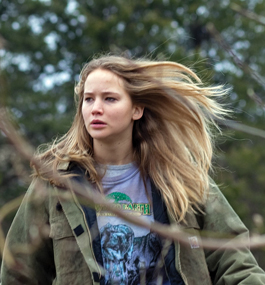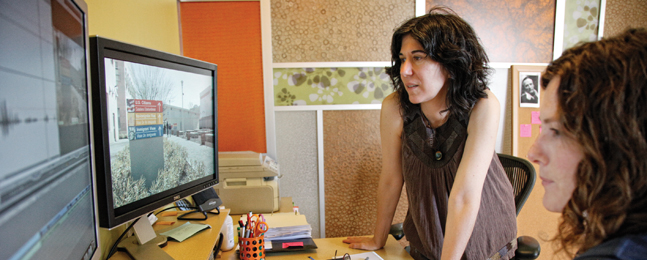Skateboarding on Hardscrabble
Even after capturing Hollywood’s attention, filmmaker Debra Granik ’85 remains fiercely independent.

Photo by Mike Lovett
by Billy Shebar
Without lots of violence, nobody feels the stakes are high enough. We live in gladiator times, blood-lust times.” At a Greenwich Village cafe not far from where she lives and works, 49-year-old writer/director Debra Granik ’85 is explaining why, after a brush with Hollywood fame, she cleaves ever more tightly to her roots as an independent filmmaker. “In Hollywood movies, somebody always has to get blown away,” she says.
“Winter’s Bone,” Granik’s meticulously observed 2010 film about a 17-year-old (Jennifer Lawrence) searching for her father among a clan of crystal meth dealers in Missouri’s Ozark Mountains, is suffused with violence, but most of it is off-screen. A gun is fired only once — to kill a squirrel for food. Yet the film garnered four Academy Award nominations, and rave reviews. It cost $2 million to make, and earned $14 million worldwide at the box office, making it the lowest grossing movie since 1983 to be nominated for Best Picture.
Granik is credited with “discovering” Jennifer Lawrence, from whom she elicited a powerful, understated performance as Ree Dolly, the film’s defiant heroine. Lawrence went on to star in “The Hunger Games,” this year’s blockbuster that has so far grossed nearly $680 million worldwide. But Hollywood’s stamp of approval has left Granik deeply ambivalent. “When people ask me about Jennifer’s trajectory from ‘Winter’s Bone’ to ‘The Hunger Games,’ I have mixed feelings,” says Granik. “What she’s doing is so far afield from what I do, I’m kind of freaked out by it.” Proposed cover art for a reissue of “Winter’s Bone” on Blu-ray exploits Lawrence’s new action hero status. “They found the most aggressive, squinty-eyed shot of Jennifer and then Photoshopped a gun into it,” sighs Granik. “They say it’s good for sales, but it wouldn’t make me want to buy it.”
Sipping mint tea, Granik reveals her antidote to Hollywood grandiosity — a set of indie tenets, some handed down from her teachers, others learned from experience. Central among them is what she calls, in a playful collision of ancient languages, “the dayenu caveat.” “Dayenu,” a Passover song of gratitude, is Hebrew for “It would have been enough for us.” “It is enough,” says Granik, “to just relish looking at the diversity of life. It is enough to look at what other people endure and suffer. It is enough to celebrate the folk wisdom of Haitian midwives, or whatever it is that blows your mind, and to create lasting evidence of that.”
page 2 of 5
A Visual Anthropologist at Heart
Before filming “Winter’s Bone,” Granik spent months observing life in the Ozarks. With the help of Daniel Woodrell, who wrote the 2006 novel on which the film is based, and location scout Richard Michael, Granik explored the unique subculture of the small valleys known as “hollers,” places of chronic poverty but tremendous resourcefulness. “Some of our crew couldn’t believe that people really ate squirrels,” recalls Granik. “But the locals couldn’t believe that we didn’t know how to capture our own dinner.” Granik went to great lengths to re-create the scenes and images that inspired her, down to the smallest visual detail. She observed a boy trying to skateboard on hardscrabble, an image that inspired her to film Ree’s little brother rolling back and forth on two plywood boards in the family’s hardscrabble yard. Granik used the house of a local family, the Laysons, as her primary location, and cast 6-year-old Ashlee Layson to play Ree’s little sister.
Granik’s commitment to realistic detail led one reviewer to call her “an authenticity freak,” an epithet she embraces. Rather than “distressing” new garments, a standard art-department practice that involves laundering clothes 30 times or more, Granik simply gave residents brand-new Carhartt jackets in exchange for their used clothing. The locals were thankful for the new jackets, and “we got old ones that really had a history to them,” she says. Granik was also struck by the indigenous banjo music. “Every single acre of land there has at least six people who can start a picking session,” she says. For the film, she staged a jam session led by local musician and storyteller Marideth Sisco, whose voice
is featured on the soundtrack.
 |
|
Sidebar Stories |
 |
A visual anthropologist at heart, Granik defines success not as winning an Oscar, or even the Grand Jury Prize at Sundance (which “Winter’s Bone” won in 2010). She dreams of getting into the Margaret Mead Film Festival, an ethnography nerd’s paradise whose recent offerings included films about Austrian yodelers, Polynesian islanders dealing with climate change and Canadian Mohawks fighting the encroachment of a golf course on their sacred woods.
Right now, she’s working on a documentary (working title: “Life at Ease”) about a Vietnam vet and biker named Stray Dog, whom she met while shooting in the Ozarks. After she wrapped “Winter’s Bone,” she went to Stray Dog’s home in a small RV park to say goodbye, and stayed for hours. “He was running from demons, haunted by violence he committed in Vietnam, and struggling with economic hardship,” says Granik. “And yet he had all these amazing ways of coping.” As Stray Dog told her about his cross-border romance with a Mexican woman and his annual participation in Ride to the Wall, a pilgrimage of bikers from all over the country to the Vietnam Veterans Memorial in Washington, D.C., Granik recognized the makings of a documentary. Here was a character who, she felt, could convey “what it’s been like to be an American for the last 50 or 60 years.”
What fuels Granik’s filmmaking, she says, is a deep-rooted desire “to gain access to lives I can’t lead.” A self-described “cliché of the East Coast Jewish liberal,” she was raised in an affluent D.C. suburb by a father who was a fair-housing litigator for the government, and a homemaker who became a feminist. In contrast, the protagonists of Granik’s films are often poor, rural and Christian, struggling with poverty and addiction. In her 2004 debut feature, “Down to the Bone,” Vera Farmiga (another Granik “discovery”) plays Irene, a working mother in upstate New York trying, with limited success, to kick a drug habit. In “Winter’s Bone,” Ree fights to save two young siblings and a catatonic mother from eviction after her meth dealing father puts their house up for bail bond, then disappears.
Granik’s creative process, which often involves nonactors playing themselves on camera, requires both filmmaker and subject to remain painfully open and nonjudgmental in the face of enormous differences. “The fuel is always my yearning to see if there are 10 places we can connect positively,” she says. “I know I’m gonna hear things that I’ll want to censor, like this really endearing person was once in the KKK — and yet there are all these other things about them that give me wonderful hope.”
Her protagonists’ struggles are quotidian — putting food on the table, fighting an addiction, dodging eviction — and redemption, if it comes, does not follow the preconceived plot points of Hollywood story craft. Instead, incremental changes flow from character and circumstance. “The typical story line in an American film about addiction is V-shaped: Someone tumbles down, they hit bottom, and then they rise up and find redemption,” she says. “But in reality it’s more like an EKG: up and down, up and down.” In “Down to the Bone,” Irene falls in love with a male nurse she meets in rehab, only to find that he’s an addict himself — a revelation so crushing that she starts using again.
What fascinates Granik is how people carry on in dire circumstances. “Coping mechanisms are very attractive to me,” she says. “I always want to know, ‘How do you do it?’” Stray Dog finds his solace and freedom on the road with fellow bikers and Vietnam brethren, in male-bonding rituals that Granik relishes having access to. “This world of men who define themselves as warriors, the ancient chivalry of it, will never cease to intrigue me,” she says.
Granik edits her footage of Stray Dog in a small office she shares with producing and writing partner Anne Rosellini and editor Tory Stewart. She describes their collaboration as “probably the closest I’ll ever get to soldiering. You go deep into an emotional territory together.” In a rough assembly of footage, Stray Dog tells Granik, “I have harmed the innocent, betrayed the innocent. … I wake up crying, and I don’t know why.” But other scenes show Stray Dog carrying on with his life: drinking moonshine and singing with his fellow bikers, praying at a “Biker’s Church” and food shopping with the Mexican girlfriend he married.
“On a bad day, some of the issues Stray Dog and his family face overwhelm me,” Granik says. “On a good day, I’m so impressed by his ability to survive and to make life have diversions and lyrical moments. Even when problems seem insurmountable, Stray Dog’s mantra is ‘Things will work out.’ The first neurochemical response in his brain is not defeatism, but patience.” Asked whether she ever feels defeated, Granik replies, “I feel it multiple times an hour. My life struggle is to find a way to wrestle with that, grapple with that, bargain with that — so that I don’t get towed under.”

Courtesy Debra Granik
As “Winter’s Bone” heroine Ree Dolly, Jennifer Lawrence delivered a powerful, understated — and career-making — performance.
page 3 of 5
A Fine Line
At Brandeis, Granik learned the hard way that a filmmaker’s desire to connect with her subject can lead to complications. For more than a year, while walking between Brandeis and her off-campus apartment on Crescent Street, Granik had been crossing paths with a homeless man named Richie. “He was living an entirely different life, of which I understood nothing,” she says, “except that he slept outside, wore peculiar clothing and seemed to have a whole system of organizing things in his cart.” She decided to make Richie the subject of her first film, for a production class taught by Henry Felt, director of Brandeis’ film and media workshop. Granik began following Richie around Waltham with a clunky VHS recorder. It was at Mount Feake Cemetery, when Richie began speaking to dead people in his own private language, that Granik realized “he was psychiatrically really, really asunder.” No longer comfortable with being a detached observer, Granik tried to help. One cold, rainy night, she couldn’t sleep knowing that Richie had no shelter. So she went out, found him and brought him home, without consulting her roommate. “She was so frickin’ freaked out because she thought he might murder us in our beds,” Granik recalls. “But all I could think was that he really needed a bath, so I let him take a bath. My roommate was so disgusted she never wanted to use that bathtub again.”
The impulse to cross the fine line between observer and participant is one Granik still struggles with, she says. She never managed to finish the film about Richie. “I got grandiose,” she explains. “I wanted to know more about him, but I couldn’t. I didn’t know how to work with the material I had.” As a Brandeis undergrad majoring in politics, Granik developed the strong sense of social justice that informs all her films. “It was thrilling to know that some of my teachers had been active in the civil rights movement,” she says. All around her, she recognized, were “very brave people who asked, ‘Why? Why does it have to be this way?’ These were scholars who had fought for crucial changes in American society. I felt inspired, reverential — and today I feel gratitude.”
She also found the perfect remedy for what she calls the “internalized anti-Semitism” that went hand in hand with her privileged upbringing: “I was just so excited to learn about the lives of working-class Jews. Every single red-diaper baby I could hear about was better than the last.” She cites the “Marx and Freud” course taught by the charismatic Gordon Fellman as a particularly formative influence. “I had been insulated from the struggle that working-class Jews and immigrants of all ethnicities had to go through to find the prestige and the good life that America was supposed to offer,” she says.
Although not an observant Jew, Granik identifies with what she sees as a Jewish mindset of curiosity and endless questioning. “But that trait also makes life heavy sometimes, and overwhelming, and unanswerable,” she says. “‘Why’ can lead you down some pretty deep rabbit holes.”
While at Brandeis, Granik joined protests against American involvement in Central America, and demanded women’s rights. “I’m old enough to remember that women had to fight for their rights,” she says. “I was not in the post-feminist era; I was deep in the frickin’ heart of it. There were a lot of female and male feminists at Brandeis, and that was exciting.” She began to explore the connection between filmmaking and activism, volunteering with the Women’s Video Collective to document protests and vigils.

Courtesy Debra Granik
Granik’s currently working on a documentary about a Vietnam vet named Stray Dog, whom she met while shooting “Winter’s Bone.”
page 4 of 5
Kunst ist Waffe
By the time Granik graduated, a revolution in video production was underway. The first portable broadcast-quality cameras were coming on the market, and public-access television gave free airtime and production facilities to anyone with an idea for a program. Granik joined Boston’s growing community of political filmmakers, and began living a communist slogan she had learned at Brandeis: “Kunst ist Waffe” (“Art is a weapon”). She remembers seeing an image of Snow White brandishing a camera like a machine gun. “That’s how I saw myself. I have this weapon, not for destructive purposes, but I am watching, I am witnessing and I am gonna record this stuff. Video was the parchment of the time.”
At a community video workshop in 1987, Granik met Laurel Chiten, the independent filmmaker who went on to make “Twitch and Shout,” the acclaimed 1994 documentary about Tourette’s syndrome. Chiten introduced Granik to a team of women filmmakers at Somerville Community Access Television, and invited her to collaborate on “Two in Twenty,” a five-episode satirical lesbian soap opera that became a cult classic. Granik persuaded her former Brandeis roommate Leah Binder ’84 — now the CEO of Leapfrog, a nonprofit that rates hospitals on safety and quality — to be an extra in a party scene. “It took her hours to shoot one small scene,” Binder recalls, but Granik’s perfectionism behind the camera came as no surprise. “Deb was always getting extensions on her term papers, because she wouldn’t settle for anything less than a masterpiece.”
As her production skills grew, Granik was hired to make videos for the Massachusetts Division of Occupational Safety, teaching supermarket cashiers how to avoid carpal tunnel syndrome and pest controllers how to put on their protective clothing. She remembers filming an exterminator as he prodded a ceiling panel in a Boston housing project and “70,000 cockroaches rained down on his head.” After the shoot, “he told me all these stories, and I realized I’d much rather be making a film about the life and times of an exterminator from Dorchester.”
Granik’s ambition to make her own films coincided with an explosion of independent filmmaking in the late ’80s and early ’90s, when low-budget indies like “Sex, Lies and Videotape” and “Clerks” were released by major studios. “There were a lot of women filmmakers emerging at the time — Susan Seidelman, Jane Campion,” she says. “Something that had seemed so mega and out of reach suddenly seemed doable.” But to make the leap, Granik felt she needed the structure of film school.

Photo by Mike Lovett
Granik and Editor Tory Stewart at footage in their New York City office. "You go deep into an emotional territory together," Granik says of her creative team.
page 5 of 5
“Look for the Attraction”
In New York University’s graduate program, Granik found her mentor, Boris Frumin, a Latvian-born director-screenwriter who emigrated in 1978 when he fell afoul of Soviet censors. Frumin introduced her to the great post-World War II European neorealist films, and to his own strict set of neorealist tenets. “He taught me to look for the attraction between characters — all the poignant, circuitous ways that people find each other,” Granik says. “And once you find it, you must do it justice.” Under Frumin’s tutelage, Granik made “Snake Feed,” a short film that got her into Sundance’s screenwriting and directing labs. Eventually, “Snake Feed” evolved into “Down to the Bone.”
To this day, Granik shows Frumin her rough cuts. As she edits footage of Stray Dog, she finds herself focusing, as Frumin would, on the complicated attraction between her subject and his younger Mexican wife. “Is it real, or does she love him for the green card?” Granik says. Granik’s compulsion to challenge herself and her audiences with harsh realities makes financing a constant struggle, even with Oscar nominations under her belt. Howard Cohen, the co-president of Roadside Attractions, which distributed “Winter’s Bone,” says it’s almost impossible for filmmakers with one indie success to re-create the perfect storm that made their first film a hit. “That’s why some indie directors jump at the opportunity to take on larger, more commercial films,” sacrificing some of their independence, Cohen says. But not Granik. Her next feature will be based on a memoir by Felicia Pearson, the Baltimore gang member who played Snoop on HBO’s “The Wire” from 2004-08. “It has an entirely black cast,” says Granik, a fact that caused one potential distributor to tell her “it would take a lifetime” to sell the film without a major star attached.
What makes Granik’s films, both documentary and dramatic, so compelling is a delicate balance of two instincts. Her first impulse is to observe and record — dayenu. But a second impulse often follows. “All of a sudden, I want to bring home the point and make something larger, to convey my enthusiasm … or my rage.”
For now, she’s obeying the dayenu caveat, concentrating on her documentary about Stray Dog. “I’d be thrilled if we can create a lasting document about a man who fought for his country, endured all the ups and downs of the last 50 years, and still finds little ways to make life worth living, like a community potluck,” she says. “I just want to show the beauty I see, even if it’s not conventional beauty. There’s something inspiring about a covered-dish supper.”
Billy Shebar is a writer and filmmaker in New York City.
